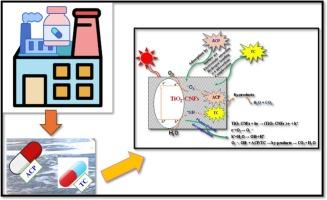高可重复利用二氧化钛-碳纳米纤维的合成及其对废水中药物污染物的高效去除
IF 5.1
3区 材料科学
Q2 MATERIALS SCIENCE, COATINGS & FILMS
引用次数: 0
摘要
近年来,药物污染物的问题日益严重,导致了各种从废水中去除药物污染物的技术的发展。本文研究了一种基于tio2负载碳纳米纤维(TiO₂-CNFs)的吸附-光催化联合降解PCs的有效方法。合成的材料具有高的热稳定性、优异的导电性、强的吸附和光催化活性,并且易于重复使用,表明其适合作为一种具有成本效益的废水处理解决方案。以对乙酰氨基酚(ACP)和四环素(TC)为模型药物污染物,评价了tio2 -CNF复合材料的吸附-光催化性能。在污水中,tio2 -CNF催化剂对ACP的去除率为96.8%,对TC的去除率为90.3%。经过8次循环后,ACP和TC的去除率分别保持在73.5%和61.2%。此外,通过总有机碳还原、自由基猝灭实验和液相色谱-质谱分析,提出了ACP和TC的去除机理。此外,还讨论了CNF吸附、TiO 2基光催化降解以及TiO 2 -CNF联合去除PCs的局限性和优点。本文章由计算机程序翻译,如有差异,请以英文原文为准。

Synthesis of Highly Reusable TiO₂–Carbon Nanofibers for Efficient Removal of Pharmaceutical Pollutants from Wastewater
Recently, the growing issue of pharmaceutical pollutants (PCs) has resulted in the development of various technologies for their removal from wastewater. This study investigates an effective method for removing PCs using a combined adsorption–photocatalytic degradation process based on TiO₂-loaded carbon nanofibers (TiO₂–CNFs). The synthesized material exhibits high thermal stability, excellent electrical conductivity, strong adsorption and photocatalytic activity, and easy reusability, indicating its suitability as a cost-effective solution for wastewater treatment. Acetaminophen (ACP) and tetracycline (TC) were selected as model pharmaceutical contaminants to evaluate the adsorption–photocatalytic performance of TiO₂–CNF composite. In sewage wastewater, TiO₂–CNF catalyst effectively removed 96.8 % of ACP and 90.3 % of TC. It also maintained high removal efficiencies of 73.5 % and 61.2 % for ACP and TC, respectively, after eight reuse cycles. Besides, total organic carbon reduction, radical-quenching experiments, and liquid chromatography–mass spectrometry analyses were conducted to propose the removal mechanisms of ACP and TC. In addition, the limitations and benefits of CNF adsorption, TiO₂-based photocatalytic degradation, and the combined TiO₂–CNF method for removing PCs were discussed.
求助全文
通过发布文献求助,成功后即可免费获取论文全文。
去求助
来源期刊

Diamond and Related Materials
工程技术-材料科学:综合
CiteScore
6.00
自引率
14.60%
发文量
702
审稿时长
2.1 months
期刊介绍:
DRM is a leading international journal that publishes new fundamental and applied research on all forms of diamond, the integration of diamond with other advanced materials and development of technologies exploiting diamond. The synthesis, characterization and processing of single crystal diamond, polycrystalline films, nanodiamond powders and heterostructures with other advanced materials are encouraged topics for technical and review articles. In addition to diamond, the journal publishes manuscripts on the synthesis, characterization and application of other related materials including diamond-like carbons, carbon nanotubes, graphene, and boron and carbon nitrides. Articles are sought on the chemical functionalization of diamond and related materials as well as their use in electrochemistry, energy storage and conversion, chemical and biological sensing, imaging, thermal management, photonic and quantum applications, electron emission and electronic devices.
The International Conference on Diamond and Carbon Materials has evolved into the largest and most well attended forum in the field of diamond, providing a forum to showcase the latest results in the science and technology of diamond and other carbon materials such as carbon nanotubes, graphene, and diamond-like carbon. Run annually in association with Diamond and Related Materials the conference provides junior and established researchers the opportunity to exchange the latest results ranging from fundamental physical and chemical concepts to applied research focusing on the next generation carbon-based devices.
 求助内容:
求助内容: 应助结果提醒方式:
应助结果提醒方式:


